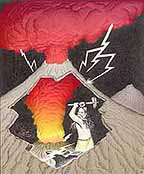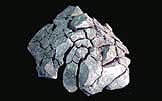
 The
small Italian island of Vulcano, provides the family
name for all volcanoes. Historic eruptions led the Romans to believe
that this island was the forge of Vulcan, son of Jupiter
and blacksmith to the Roman gods, as depicted in the image left,
with permission from the artist, Jeffrey Hulen. The island of
Vulcano also gives its name to a particular eruption style --
vulcanian. Vulcanian eruptions initially occur as a series
of discrete, canon-like explosions that are short-lived, lasting
for only minutes to a few hours, often with high-velocity ejections
of bombs and blocks. Once the volcano "clears its throat,"
however, the subsequent eruptions can be relatively quiet and
sustained. Vulcanian eruptions are more explosive than Strombolian
eruptions
with eruptive columns commonly between 5 and 10 km heigh. The
volume of tephra produced is relatively small (less than one cubic
kilometer), but dispersed over a moderately wide area. Periodic
on-going vulcanian activity is currently exhibited by the Sakurajima
volcano
in Japan, and by the Tavurvur volcano in Papua New Guinea,
shown in the following images:
The
small Italian island of Vulcano, provides the family
name for all volcanoes. Historic eruptions led the Romans to believe
that this island was the forge of Vulcan, son of Jupiter
and blacksmith to the Roman gods, as depicted in the image left,
with permission from the artist, Jeffrey Hulen. The island of
Vulcano also gives its name to a particular eruption style --
vulcanian. Vulcanian eruptions initially occur as a series
of discrete, canon-like explosions that are short-lived, lasting
for only minutes to a few hours, often with high-velocity ejections
of bombs and blocks. Once the volcano "clears its throat,"
however, the subsequent eruptions can be relatively quiet and
sustained. Vulcanian eruptions are more explosive than Strombolian
eruptions
with eruptive columns commonly between 5 and 10 km heigh. The
volume of tephra produced is relatively small (less than one cubic
kilometer), but dispersed over a moderately wide area. Periodic
on-going vulcanian activity is currently exhibited by the Sakurajima
volcano
in Japan, and by the Tavurvur volcano in Papua New Guinea,
shown in the following images:
|
|
In contrast to basaltic strombolian eruptions, vulcanian eruptions are most often associated with andesitic to dacitic magma. The high viscosity of these magmas makes it difficult for the vesiculating gases to escape. This leads to the build up of high gas pressure and explosive eruptions. The ejected lava fragments do not take on the aerodynamic shapes common to Strombolian eruptions. This is partly due to the higher viscosity of the erupting magma, but also because the ejecta often incorporates a high proportion of crystalline material broken away from the rock plugging the throat of the volcano. These eruptions are often associated with growing lava domes, such as that at Mt. Pelée in 1902, and with the genration of pyroclastic flows from dome collapse.
 Vulcanian deposits contain large blocks
and bombs near the vent. Bread-crust
bombs (left) are particularly abundant. These resemble
a crusty loaf of bread broken by deep cracks that often expose
a frothy interior. These large pyroclastic fragments form when
viscous, gas-rich magma is ejected from the vent to produce a
bomb whose exterior chills quickly to a glassy or fine-grained
crust while in flight. The interior of the bomb, however, continues
to vesiculate on the ground, which leads to expansion of the interior
and cracking of the brittle outer crust.
Vulcanian deposits contain large blocks
and bombs near the vent. Bread-crust
bombs (left) are particularly abundant. These resemble
a crusty loaf of bread broken by deep cracks that often expose
a frothy interior. These large pyroclastic fragments form when
viscous, gas-rich magma is ejected from the vent to produce a
bomb whose exterior chills quickly to a glassy or fine-grained
crust while in flight. The interior of the bomb, however, continues
to vesiculate on the ground, which leads to expansion of the interior
and cracking of the brittle outer crust.
Although blocks and bombs are common in proximal deposits, the bulk of Vulcanian deposits is very fine grained and dominated by ash. The abundance of ash indicates a high degree of fragmentation, which can only be generated by magmas with high gas contents. In some cases, these high gas contents are derived from heated meteoric water. It is likely, therefore, that many vulcanian eruptions are at least partially hydrovolcanic. Although the ash-fall deposits generated by volcanian eruptions are highly fragmented, they are only moderately dispersed. This suggests a high degree of explosiveness (high fragmentation) associated with the development of eruptive columns that are of only moderate heights (moderate dispersal).